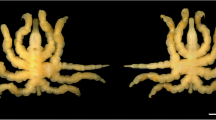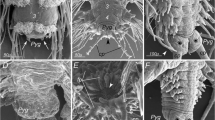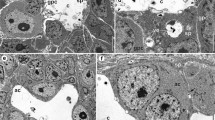Summary
The development of abdominal segments in Spirorbis moerchi (Polychaeta: Annelida) was studied by light and electron microscopy. Abdominal segments develop in strict succession from anterior to posterior. Segmentation is initiated in the mesoderm and is followed by segmentation of the ectoderm. The mesoderm of the abdominal segments arises entirely from pygidial residual mesoderm; inward migration of cells from the pygidial ectoderm to give rise to mesoderm does not occur. The primordial germ cells remain distinct from the residual mesoderm of the pygidial growth region. After several abdominal segments have developed, the primordial germ cells “migrate” posteriorly from the achaetous region, invade the abdominal segments, and give rise to the retroperitoneal gonads. Abdominal segment formation is discussed in terms of heteronomy, primordial germ cell origin, gonad formation, and development of the circulatory system.
Similar content being viewed by others
References
Åkesson B (1962) The embryology of Tomopteris helgolandica. Acta Zool (Stockholm) 43:135–199
Anderson DT (1959) The embryology of the polychaete Scoloplos armiger. Q J Micros Sci 100:89–166
Anderson DT (1966) The comparative embryology of the polychaeta. Acta Zool (Stockholm) 47:1–42
Andrews JC, Anderson DT (1963) The development of the polychaete Galeolaria caespitosa Lamarck (fam. Serpulidae). Proc Linn Soc N S W 87:185–188
Breton-Gorius J (1963) Étude au microscope électronique des cellules chloragogènes d' Arenicola marina L. Annls Sci nat Zool sér 12 5:211–272
Dales RP (1962) The polychaete stomodaeum and the interrelationships of the families of Polychaeta. Proc Zool Soc London 139:289–328
Eckelbarger KJ (1975) A light and electron microscope investigation of gametogenesis in Nicolea zostericola. Mar Biol 30:353–370
Eckelbarger KJ (1979) Ultrastructural evidence for both autosynthetic and heterosynthetic yolk formation in the oocytes of an annelid (Phragmatopoma lapidosa: Polychaeta). Tissue & Cell 11:425–443
Häcker V (1894) Die spätere Entwicklung der Polynoe — Larve. Zool Jahrb Abt Anat Ontog Tiere 8:245–288
Hama K (1960) The fine structure of some blood vessels of the earthworm Eisenia foetida. J Biophys Biochem Cytol 7:717–724
Hanson J (1949) The histology of the blood system in oligochaetes and polychaetes. Biol Rev Cambridge Philos Soc 24:127–173
Hanson J (1951) The blood-system in the Serpulimorpha (Annelida, Polychaeta). III. Histology. Q J Micros Sci 92:255–274
Hegner RW (1914) The germ cell cycle in animals. MacMillan: New York
Iwanoff PP (1928) Die Entwicklung der Larval segmente bei den Anneliden. Z Morphol Oekol Tiere 10:62–161
Iwanoff PP (1933) Die Embryonale Entwicklung von Limulus moluccanus. Zool Jahrb Abt Anat Ontog Tiere 56:163–348
Iwanoff PP (1944) Primary and secondary metamery of the body. (Russian with English summary by P.G. Svetlov). J Gen Biol Moscow 5:61–95
Malaquin A (1924a) Les glandes génitales et les cellules sexuelles primordiales chez l'annélide Salmacina dysteri (Huxley). La génèse des ébauches génitales par les gonocytes extracoelomiques. CR Acad Sci Paris 179:1348–1351
Malaquin A (1924b) Les glandes génitales et les cellules sexuelles primordiales chez l'annélide Salmacina dysteri (Huxley). La filiation des cellules sexuelles (gonocytes); leur origine dans le bourgeon caudal. CR Acad Sci Paris 179:1636–1639
Malaquin A (1925) La ségrégation au cours de l'ontogenèse de deux cellules sexuelles primordiales, souches de la lignée germinale chez Salmacina dysteri (Huxley). CR Acad Sci Paris 180:324–327
Malaquin A (1934) Nouvelles observations sur la lignée germinale de l'annélide Salmacina dysteri (Huxley). CR Acad Sci Paris 198:1804–1806
Manton SM (1949) Studies on the Onychophora. VII. The early embryonic stages of Peripatopsis and some general considerations concerning the morphology and phylogeny of the Arthropoda. Phil Trans Roy Soc London, Ser B 233:483–580
Meyer E (1888) Studien über den Körperbau der Anneliden IV: Die Körperform der Serpulaceen und Hermellen. Mitt Zool Stat Neapel 8:462–662
Nakao T (1974) An electron microscopic study of the circulatory system in Nereis japonica. J Morphol 144:217–236
Newby WW (1940) The embryology of the echiuroid worm Urechis caupo. Memoirs Amer Phil Soc Philadelphia: Wistar Inst Symp Monogr 16:1–219
Olive PJW (1971) Ovary structure and oogenesis in Cirratulus cirratus (Polychaeta: Cirratulidae). Mar Biol 8:243–260
Potswald HE (1964) The nature of the primordial germ cells and evidence for self-fertilization in Spirorbis (Polychaeta, Serpulidae). Am Zool 4:292
Potswald HE (1965) Reproductive biology and development of Spirorbis (Serpulidae, Polychaeta). Ph.D. Thesis, University of Washington, pp 1–330
Potswald HE (1967) Observations on the genital segments of Spirorbis (Polychaeta). Biol Bull 132:91–107
Potswald HE (1968) The biology of fertilization and brood protection in Spirorbis (Laeospira) morchi. Biol Bull 135:208–222
Potswald HE (1969) Cytological observations on the so-called neoblasts in the serpulid Spirorbis. J Morphol 128:241–260
Potswald HE (1972) The relationship of early oocytes to putative neoblasts in the serpulid Spirorbis. J Morphol 137:215–228
Potswald HE (1978) Metamorphosis in Spirorbis (Polychaeta). In: Chia FS, Rice ME (eds) Settlement and metamorphosis of marine invertebrate larvae. Elsevier/North-Holland Biomedical Press, New York pp 127–143
Reggiani MP (1957) Osservazioni sull' origine delle cellule germinali e il differenziamento dei gameti nel polichete ermafrodita Spirorbis pagenstecheri. Q Riv Biol 49:243–263
Schroeder PC, Hermans CO (1975) Annelida: Polychaeta. In: Giese AC, Pearse JS (eds) Reproduction of marine invertebrates Vol III. Academic Press, New York pp 1–213
Segrove F (1941) The development of the serpulid Pomatoceros triqueter L Q J Micros Sci 82:467–540
Shearer C (1911) On the development and structure of the trochophore of Hydroides uncinatus (Eupomatus). Q J Micros Sci 56:543–590
Torrey JC (1903) The early embryology of Thalassema mellita (Conn). Ann NY Acad Sci 14:165–246
van Gansen P (1962) Plexus sanguin du lombricien Eisenia foetida: étude au microscope électronique de ses constituants conjonctif et musculaire. J Micros 1:363–376
Wilson EB (1890) The origin of the mesoblast-bands in annelids. J Morphol 4:205–219
Wilson EB (1925) The cell in development and heredity. 3rd ed. MacMillan: New York
Author information
Authors and Affiliations
Rights and permissions
About this article
Cite this article
Potswald, H.E. Abdominal segment formation in Spirorbis moerchi (Polychaeta). Zoomorphology 97, 225–245 (1981). https://doi.org/10.1007/BF00310278
Received:
Issue Date:
DOI: https://doi.org/10.1007/BF00310278




